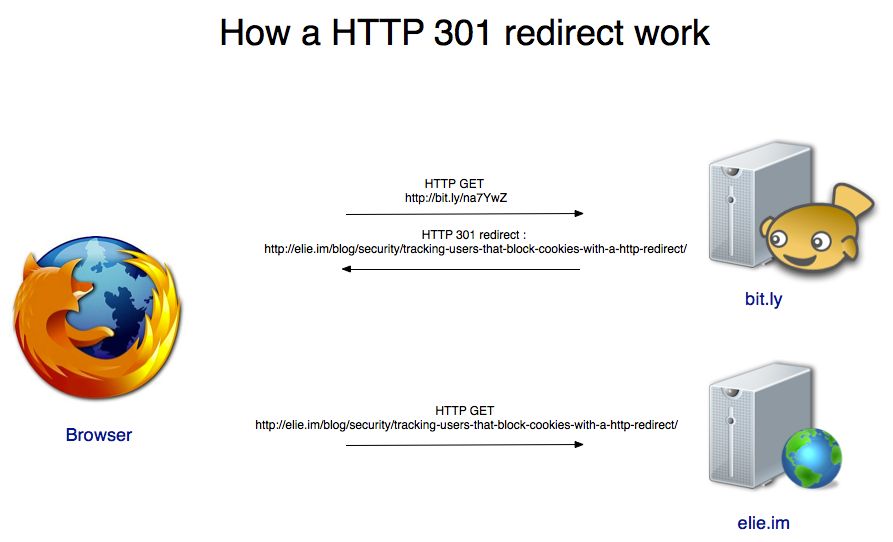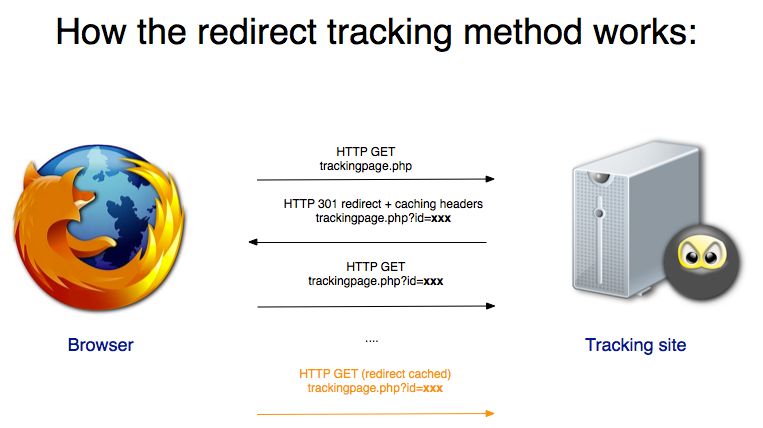While the standard technique to track users across multiples sites / visits is to use cookies this is by no means the only way to do this. Last year Samy, with his famous evercookie application, showed that in fact many browser storages (Flash, locale storage) can be used to store a unique identifier that can act as cookie. In this post, I will share with you a new tracking technique (AFAIK) that works even when all the browser storages mechanisms are blocked/disable. (**edit: **@theharmonyguy founded this article about a somewhat related technique that use redirect to pass cookies). What makes this technique unique and hard to block is that it does not rely on a storage mechanism or a JavaScript trick but instead abuse the HTTP mechanism used to make shortened URLs work: the HTTP redirect header. Because this tracking technique rely on a HTTP header it will work even if javascript and the browser plug-ins (Flash, Silverlight) are disable.
Background
In essence this technique that I call “redirect tracking” works by abusing the HTTP 301 redirect mechanism to redirect each user to unique URL. HTTP 301 redirects are used by web-server to tell browsers that the requested URL is redirected “permanently” to another one. This mechanism was first designed to allow website to correct user mistakes or redirect multiples domains to a single one. Nowadays the most prominent use of 301 redirects are shortening URL services. For example when using the short URL http://bit.ly/na7YwZ to access this blog post the following interaction is taking place under the hood:

How a HTTP 301 redirect work In the first step your browser requests from bit.ly the content of the short URL. Bit.ly answers by saying that this content is permanently located at the URL. The browser caches this information and navigates to the redirected url.
How does it work ?
The redirect tracking method works almost the same way except it use the redirect to plante the unique identifier:

When the user request the tracking page, its code will look at the URL path/parameters to see if there is a unique identifier such as hxxp://evil.com/track.php?id=xxx. If the URL does not contains a unique identifier hxxp://evil.com/track.php then the tracking page uses the HTTP 301 headers to assign a unique identifier to the user, redirecting to: hxxp://evil.com/track.php?id=xxx. When the redirection occurs the browser will cache the redirect information so the next time the user connect to the tracking page the user will be redirected to the tracking page with his unique id.
Browser compatibility
I tested this technique on Firefox 5, Internet Explorer 9 , Safari and Chrome: it works on all of them except the new versions of Safari. There is a couple of interesting quirks to take into account while using this method:
- You need to add caching headers otherwise it won’t work on Firefox and Internet Explorer
- The only redirect code that works is the 301. Every others one is not cached.
- On Chrome and Firefox sometime the first redirect is not cached. I have no idea why. Opening a new tab seems to help.
- The technique used to work on Safari but does not to work on the new version. I dont know when this changed. If you have an idea how to make it work on Safari let me know
- The redirect is cached even between browser restart so it is almost as reliable as a cookie.
Demo
IF you want to play with the code you can get it from Github Thanks to Andrew Bortz: He was the first to research in a systematic way how to track user with a simple HTTP request and this technique was born from our discussion.
Thank you for reading this post till the end! If you enjoyed it, don’t forget to share it on your favorite social network so that your friends and colleagues can enjoy it too. To get notified when my next post is online, follow me on Twitter, Facebook, or LinkedIn. You can also get the full posts directly in your inbox by subscribing to the mailing list or via RSS. A bientôt!




